Here's the plan for the Madison Ave Road Diet
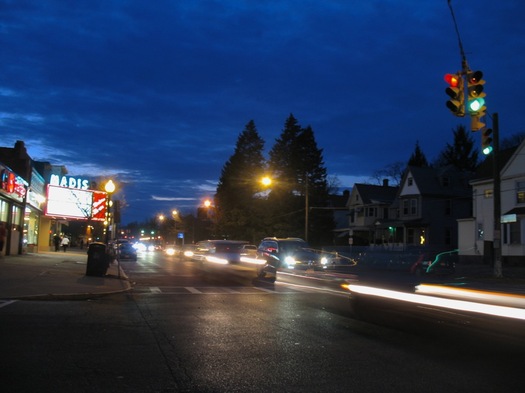
Standing at Madison and Main ahead of Wednesday night's meeting.
The city of Albany has made a choice of which direction to go on the much-discussed Madison Avenue Road Diet, a plan to calm traffic along the busy corridor in an effort to make it safer -- and, at the same time, friendlier to pedestrians and cyclists.
The long-developing project has recently been getting more attention because of a push for the inclusion protected bike lanes in the road re-design. A coalition supporting the idea has argued the lanes are both safer for cyclists and feel safer, which would lead to more people cycling.
Consultants for the project explained the reasons for the selected choice at a public meeting Wednesday evening at Saint Rose. So, without further ado, here's the selected plan.
Diagrams
The process for picking the recommended plan narrowed the range of choices from five design options to two. If you'd like to compare designs for the two final options, they're above in large format -- click or scroll all the way up.
The selected plan
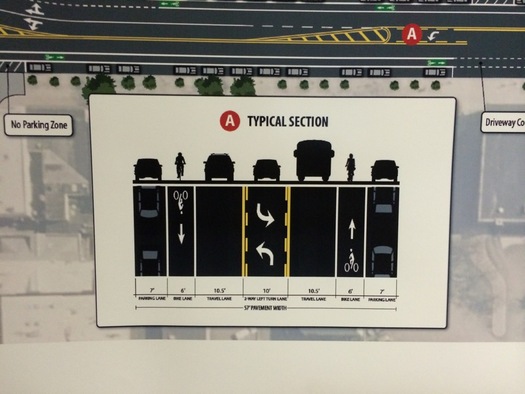
The city has selected the option that includes:
+ One vehicle travel lane in each direction, plus a center turn lane.
+ Parking along the curb.
+ Conventional bike lanes that run between the vehicle travel lanes and the parked cars.
So, the plan does not include protected bike lanes.
Representatives of Creighton Manning, an engineering firm that has been working with the city on the road diet, told the crowd Wednesday night the range of options had been narrowed to two candidates based on earlier public input and study of the corridor and the experiences of other cities: the conventional bike lane version selected and a second option that included protected bike lanes that would have run on both sides of Madison between the curb and parked cars.
The Creighton Manning reps presented a series of projected impacts for both options -- on parking, maintenance costs, and bike ridership, and travel time along the corridor:
Capital cost
Conventional bike lane option: $1.3 million
Protected bike lane option: $1.6 million
The extra cost for the protected lanes included items such as bollards for separating the lanes from the parked cars.
Maintenance cost
Conventional: $61,000 per year
Protected: $91,000 per year + an upfront cost of $210,000 for machinery to sweep the lanes and clear them of snow

Number of parking spaces affected
Conventional: 45
Protected: 200
Creighton Manning's Mark Sargent said the protected bike lane plan eats up a lot more spaces for two reasons: 1) the zones for the bus stops needed to be longer so buses could make their way to the curb and 2) guidance on protected lanes indicated each driveway would require a 20-foot buffer on each side.
Estimates of bike ridership
Current: 26 per hour
Conventional: 41 per hour
Protected: 49 per hour
Corridor travel time effects
Sargent said it was difficult to quantify the difference in potential effect on travel times for each bike lane option. But both options probably would increase travel times in the 30-45 second range. There would also be noticeable delays at the intersections with South Allen Street and New Scotland Ave during peak traffic periods.
Overall
Sargent showed a matrix comparing the various effects of each plan (it was also display in the back of the forum -- that display is below).

He said of the tradeoffs: "They're very real. They're quantifiable." And he pointed out that cyclists represent a very small slice of all the users of the corridor:
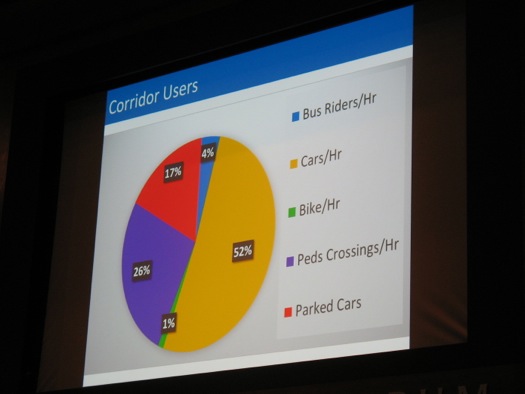
Jeff Pangburn, also of Creighton Manning, told the crowd he's a biker and wouldn't choose to bike on Madison Ave as it's currently configured. But with the conventional bike lane option -- and the overall road diet: "It's a dramatic improvement over what's out there."
And Sargent later said during the public comment period that a study had concluded there were 471 accidents in this corridor over a 3-year period. He said they're projecting the road diet plan will reduce that number by 25 percent.
Kathy Sheehan
After the public presentation, mayor Kathy Sheehan said she was taking ownership of the decision to select the conventional bike lane option, and pointed to it being cost effective while still including increased accommodations for bikes. She also touched on the contentious nature of the whole road diet topic:
"Looking at the parking impact, and whether the parking impact exists, we need to insure that the strong businesses that we have in the corridor -- and people who live in the corridor -- that their needs are being met. We have people living along Madison Ave who don't want us to do this project at all. I was just stopped by a couple of who want this put to a vote, they feel that strongly against doing anything. And so I think this is a good start. We have to prove to the community that this is going to work. That is what we have to move forward on, to stop talking and actually get it implemented."
We asked the mayor about the people who might be disappointed by the decision to not go with the protected bike lane option, and a possible sense among some of them that bypassing the option is evidence the city isn't up for trying new ideas. Her response:
"We have to think about all users of this road. This is not just for bikes. And I know there are adamant bicyclists who think, 'Hey, just go for it and we'll prove to you because so many more people will just come out and patronize these businesses.'"
"We have to get emergency vehicles up and down this street. We have to make sure that we have lanes that are open for emergency vehicles to get to hospitals. When you start to look at the restrictions in the flow of traffic caused by having the protected bike lanes, you're really restricting that access. When we have that first snowstorm and we have people parking against not the curb to measure from, but bollards which we know in the winter are difficult to see and get knocked down. Again, I listen to the experts. And the experts who looked at this project -- and who are big bike advocates across the country -- who said that for this road the conventional bike lanes is the right treatment. Because if you go with protected bike lanes -- and all those of issues that I just talked about -- that will be the end of this discussion. You heard from the skeptics in this audience -- who, again, don't want any bike lanes, they don't want us to do anything at all -- and so we need to make sure we listen to everyone in our community, that we take all of those people into consideration, and take the best choice. Again, these were two really great choices. [And] pick the best choice for this road."
"That doesn't mean protected bike lanes are dead in the city of Albany. Far from it."
Sheehan said the city is currently looking at doing bike-specific projects -- as opposed to bike amenities within a larger road safety project -- on other corridors in the city, specifically Broadway in the Warehouse District and Clinton Avenue on the city's northern side.
"There's absolutely opportunity when looking at the widths [of those streets] and the way that traffic flows that those would be candidates that we should be looking hard at for protected bike lane treatment," she said. "I'd love to see us connect the rail trail as it comes into the city to a network that at least provides for conventional and/or protected bike lanes all the way to the Warehouse District."
Reaction from protected bike lane advocates
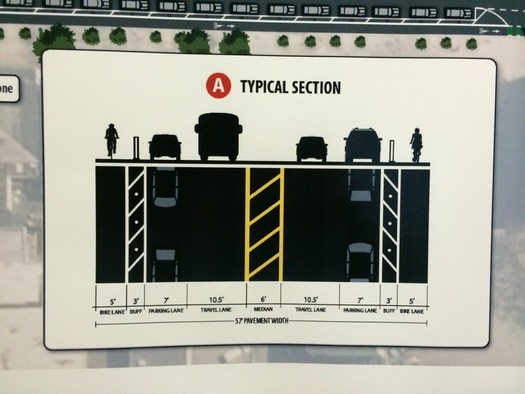
The final option that included protected bike lanes.
Jason D'Cruz has been one of the representatives of the Albany Protected Bike Lane Coalition:
"I worry that this is the sort of compromise that's going to make no one fully satisfied. ... This was really a rare opportunity for Albany to get its first protected bike lane. And Madison is the only avenue -- an east-west connector road that is wide enough to accommodate a protected bike lane. So this was a huge opportunity for us, and we feel like it's something of a missed opportunity. We're happy about the traffic calming. We're happy about a safer street. But for cyclists who are not pros, experts, really dedicated transportational cyclists, the whole diverse range of people who bike around this area and in the park who don't feel like they'll be safe riding on a bicycle lane between parked cars and moving cars, that puts cyclists in a pretty precarious situation... so, yeah, disappointment in the decision."
(The coalition also announced after Wednesday's meeting that it's changing its name to Capital Region Complete Streets, with a focus "to advocate for safe transit for all people regardless of their age, socioeconomic status, ability, or mode of transport.")
Virginia Hammer is president of the Pine Hills Neighborhood Association -- she's been an advocate for the road diet idea for more than a decade, and recently has also been a proponent for protected bike lanes. She said it would have been "fabulous" to get protected bike lanes, but she noted the political realities of the situation, including some vocal opposition along the corridor:
"I believe that the road diet, with some accommodations for bicyclists, though not perfect, is a good solution. And the city administration and the consultants have come a really long way in understanding what protected bike lanes are and what they mean. And what the possibilities are for putting them on other streets, which might be deemed to be more appropriate for the first time. ... We put protected bike lanes on the front of the burner for a lot planners and things. And I think we can look forward to having protected bike lanes in some parts of Albany."
What's next?
The plan for the road diet is to implement it in three segments: Allen to Partridge, then Partridge to South Lake, then South Lake to Lark. Creighton Manning's Jeff Pangburn said the goal is to have the first segment reconfigured by the end of this summer. If the funding for the second segment comes through -- much of this project is being funded by the state -- that could be completed late this year. And the ultimate goal is to have all three segments finished by end of 2017.
Earlier
+ A new pitch for protected bike lanes in Albany
+ Options for the Madison Ave Road Diet
+ Three thoughts about the push for protected bike lanes in Albany
Say Something!
We'd really like you to take part in the conversation here at All Over Albany. But we do have a few rules here. Don't worry, they're easy. The first: be kind. The second: treat everyone else with the same respect you'd like to see in return. Cool? Great, post away. Comments are moderated so it might take a little while for your comment to show up. Thanks for being patient.
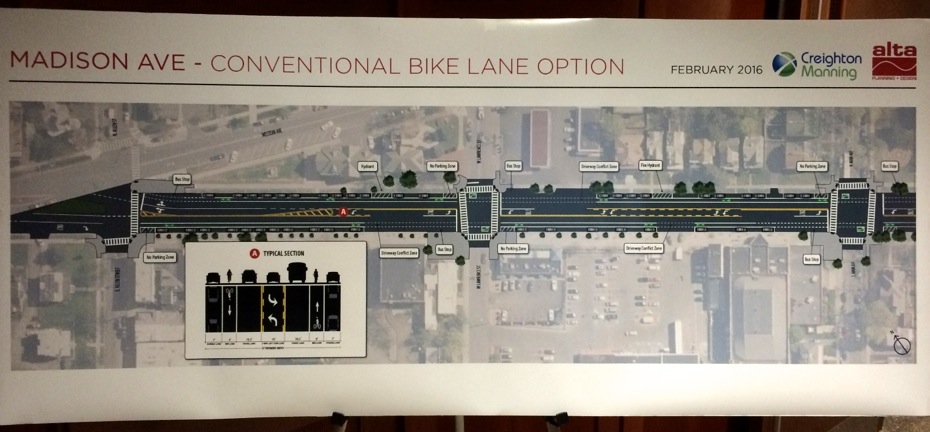

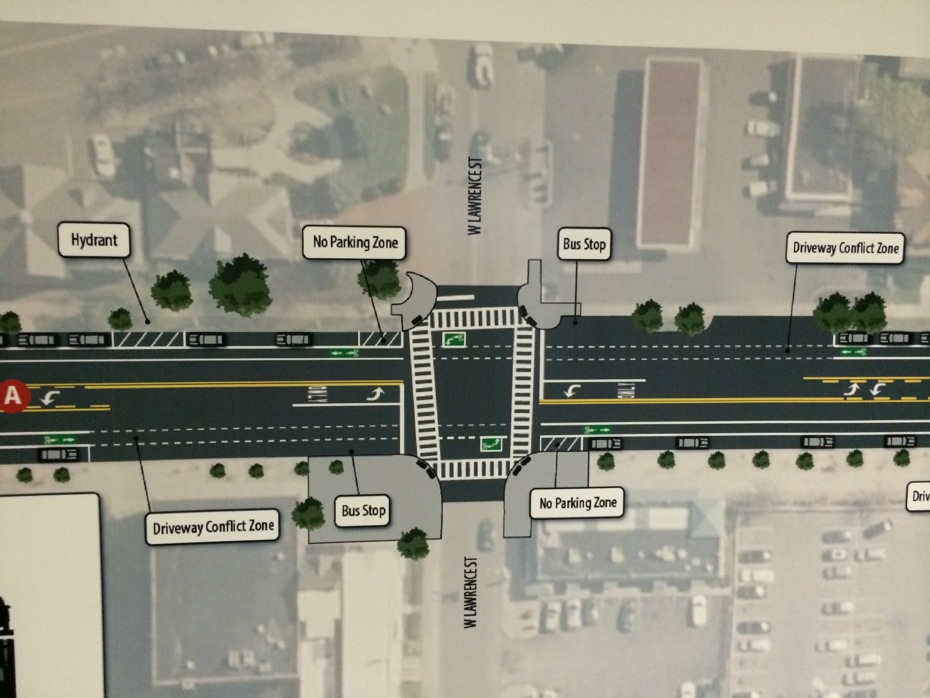
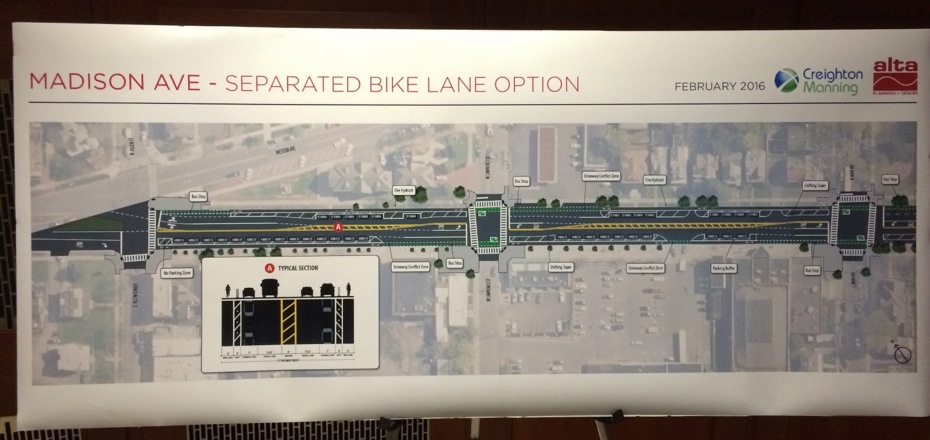
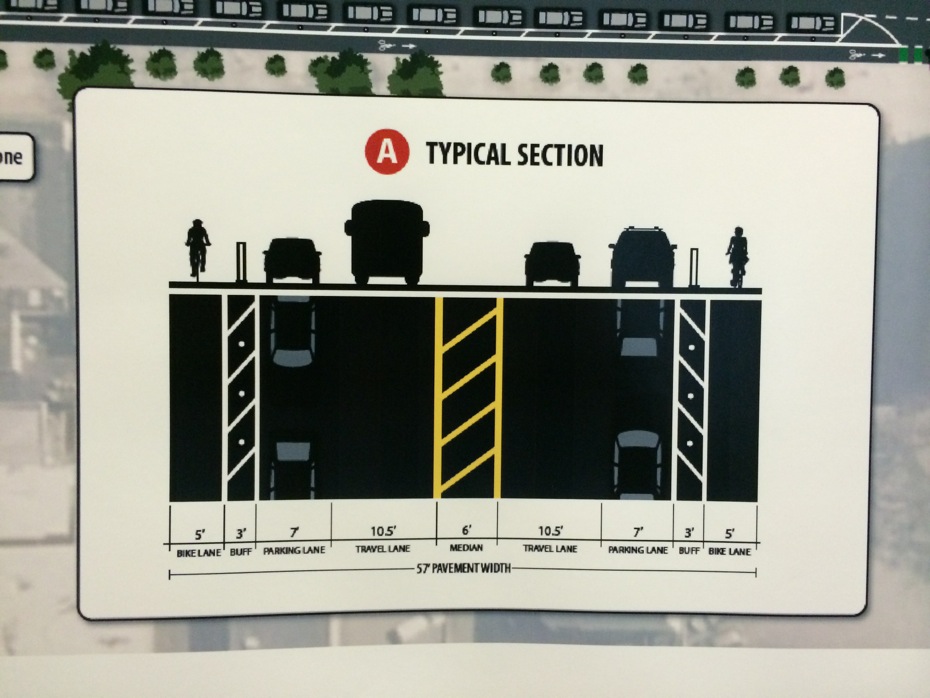
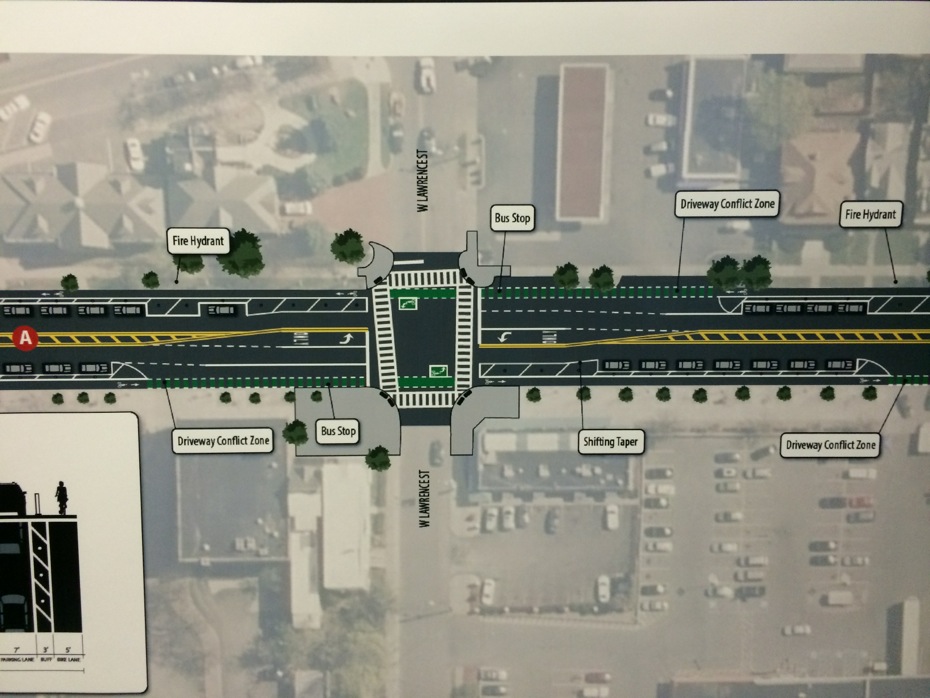
Comments
This is typical Albany think small do as little a possible. Did anyone really think the separated bike lane was going to happen?
... said Bill on Mar 10, 2016 at 6:21 AM | link
The double parking residents of Albany ought to make this idea interesting!
... said Fox on Mar 10, 2016 at 8:14 AM | link
Thanks for the fast, accurate and complete reporting! You deserve awards.
I was glad to hear the city will repave. Portions of that street are in very bad shape.
A couple of the folks against reconfiguration seemed concerned about increased traffic congestion with its attendant emissions and loud stereos. I get that. I wouldn't support increased motor vehicle congestion on my street. That said, if I lived on a busy street where motor vehicles routinely traveled past my house at 35 to 40 mph, I'd think twice before objecting to a plan proven to slow motor vehicle traffic and encourage bicycling. If in practice the motor vehicle traffic is slowed too much, motorists will go elsewhere. The same way water flows to the lowest point, motorists change routes if their existing route becomes too congested. That'd be a win. If in practice more people bike on Madison Avenue, that'd also be a win--remember bicycles don't pollute and generally don't have stereos.
Another concern raised was increased travel time. The projected increase in travel time for the 12 block corridor is less than a minute. I hope you can spare a minute, maybe even two, in exchange for reduced traffic fatalities. Indeed, some communities are recognizing that prioritizing faster motor vehicle travel above human life is wrong. They're aiming for zero traffic fatalities. Example? http://www.nyc.gov/html/visionzero/pages/home/home.shtml. Human life should always be valued over faster travel times.
Worried about the money? All Madison Avenue property owners are going to see their property values go up. Residential sellers will find more buyers willing to relocate to a quiet street with slower traffic than to a home on the side of a highway. Commercial owners will find that inviting bicycle users to their businesses will increase sales. We tend to spend our money closer to home and don't care at all about parking (but appreciate a well placed bicycle rack).
And please--let's put to bed the misconception that bicycle users don't pay taxes. We pay the same taxes as motor vehicle users, because we are motor vehicle users. We own or rent motor vehicles, just like you, but we opt to use bicycles when we travel short distances in the city. You should try it. It can be a very pleasant way to travel.
And please remember--if all road users, motorized and not, traveled the speed limit, stopped at signals and signs and then looked before proceeding, didn't drink, didn't text and used caution when passing vulnerable road users, we wouldn't have needed to change Madison Avenue at all. When road users share nicely, any old road will do. Pothole free, though, please.
So the die is cast. Let's keep open minds and play nice together.
... said Randal Putnam on Mar 10, 2016 at 8:20 AM | link
I see this as a bittersweet development. While protected bike lanes would have been a great boon (given that this one of the few east-west corridors that could handle it), at the end of the day this is great news for pedestrian safety, will make travel by vehicle and bus more efficient and safe for all who use this corridor, and modernize the corridor. I’m am excited to hear that protected bike lanes will still be explored elsewhere, which once installed, will help convince opponents of their benefits. I’m especially happy to see Broadway be considered. As a frequent biker down at the Corning Preserve, only the brave pull off to head up Broadway to the Warehouse District for a quick bite or nip of beer. I think a protected bike lane will create some nice synergies between the Warehouse District and the waterfront (and downtown for that matter), which is the next natural (and crucial) evolution for this corner of the city.
... said Rich on Mar 10, 2016 at 8:35 AM | link
I echo Jason D'Cruz's quoted text in that I'm disappointed that the protected bike lane wasn't chosen, but not surprised, and I completely understand the reasoning for it.
As a parent, I loved the idea that my family could use the protected bike lane to get down to Washington Park or Lark Street. However, the chosen scheme would still keep me, a seasoned cyclist with many years of racing under my belt, still using the back-roads to get to the same destinations.
... said Sean on Mar 10, 2016 at 8:45 AM | link
I’m disappointed, but not surprised. One downside to conventional bike lanes in many areas is that they are frequently blocked by cars… double-parked cars, poorly parked cars, and drivers pulling into them to make right-hand turns, etc. I hope that enforcement efforts are made to prevent this.
... said Sarah Rain on Mar 10, 2016 at 9:15 AM | link
Interesting arithmetic, however:
road width is 57', of which 14' are taken by two 7' parking lanes, leaving 43' of disposable space. Right now that means 4x10.75' driving lanes.
Reasonable diet means 2x10.5' driving lanes and 10' turning lane, 31' total. 12' can be used for bicycles - or one full lane.
Suddenly it turns out that 12' is not enough for protected lanes, 16' - or 1.5 travel lanes - are required for 2 bicycle lanes. Which brings the question if bicycles actually need much less road travel space...
... said Mike on Mar 10, 2016 at 9:33 AM | link
A reasonable compromise by the Mayor. If this plan actually brings business to Madison Avenue, making it safer and more family-friendly, I'll be happy to admit I was wrong. But I'm betting the only effect of turning Madison Avenue from a four-lane road into two lanes with a turning lane in the middle will be to tie up traffic and annoy people. Looking forward to seeing the promised flocks of moms, dads and kids filling those new lanes!
... said Al Quaglieri on Mar 10, 2016 at 9:53 AM | link
Great points Randal & Rich.
I went to the meeting hoping for protected bike lanes, and fearful that no bike lanes would be provided. While I would have preferred protected lanes, I think the city and CM did a great job explaining why they selected the option they did, and I really couldn't find fault with it. It's far from ideal for cyclists for the reasons mentioned above, but it is a great step forward for everyone.
One thing that occasionally seemed to get lost in all the discussion about bike lanes; the road diet is happening, and needs to happen, regardless of bicycle use. The city is not trading car lanes for bike lanes, that is just a side benefit.
Another question/comment that came up was enforcement of bicycle infractions. I agree that everyone should have to play by the rules, but the mentality projected by the commenter neglects the fact that flouting of bicycle traffic laws is often exacerbated by lack of adequate & safe infrastructure. Better infrastructure and more users should result in better compliance.
... said Ed on Mar 10, 2016 at 10:11 AM | link
Per the Mayor: "...restrictions in the flow of traffic caused by having the protected bike lanes, you're really restricting that access. When we have that first snowstorm and we have people parking against not the curb to measure from, but bollards which we know in the winter are difficult to see and get knocked down."
Bike lanes, car lanes, turning lanes or not, the point becomes moot when there's snow and it needs to be plowed and put somewhere.
... said Andy G on Mar 10, 2016 at 11:45 AM | link
Why aren't the bike lanes on the outside? I would've thought sidewalk/bike/parking/cars would be ideal.
... said ac777 on Mar 10, 2016 at 3:16 PM | link
I preferred the protected lane option. I'm disappointed, but I think that this is great progress. I believe that previous administrations and council would not have done as well balancing the needs of the residents, commuters, and businesses - and in the end this plan has balance. It is a start. I drive, walk, and bike along Madison each and every day of the week. Mode depends a lot on the nature of my trip, weather, and time of day. Madison was overbuilt to one standard - getting cars as quickly as possible through the neighborhood by nature of speed. The traffic volumes, crash data, and unwarranted vehicle speeds illustrate a need for a plan that manages flow. A center turn lane that eliminates vehicles cueing in a travel lane? Awesome. Three lanes to cross as a pedestrian, opposed to two? Awesome. Reduced sudden and desperate left turns across two lanes of speeding cars? Awesome. A bike lane that encourages and supports safe, predictable, riding while a the same time encouraging riders to ride within law? Awesome.
Did everyone get everything they wanted? No. But this street got a real boost to improve safe traffic flow, encourage cycling, protect pedestrians, enhance transit, and positively impact quality of life for the thousands of people that live within a few blocks of this significant corridor.
It may not feel like the biggest win, but it is indeed a significant win.
... said daleyplanit on Mar 10, 2016 at 3:51 PM | link
I am all for less accidents on the streets.
Have not seen any accidents on Madison Ave in a long, long time!
As Al Q. demonstrated while riding his bike all the way down Madison Ave there were NO bikes using this street!
One percent of the road users will have the whole city paying higher taxes and , being inconvenienced.
Our tax dollars should be going towards new sewers, and storm drains.
Price Chopper & CVS are NOT GOING TO BE HAPPY CAMPERS while getting their deliveries made after the lanes are changed!
The four empty stores on the next block, and one on my block will multiply .
This is a case of "If you build it THEY WILL GO", NOT COME!
The road does need paving , and the speed limit should be lowered, and enforced.
I have lived here all my life and seen a lot of changes, not all for the better.
... said mg on Mar 11, 2016 at 10:42 AM | link
@mg - this change is happening, with or without the bicycle lanes. this change is better for the community, with or without the bicycle lanes. this change is being 80-90% funded by grants, with or without the bike lanes. blaming/crediting the bike lanes & bicycle users is not going to stop this change.
... said Ed on Mar 11, 2016 at 12:25 PM | link
@mg I'm pretty sure Price Chopper has off-street delivery, and CVS deliveries just double-park anyways.
Just because YOU don't see crashes or bicyclists does not mean that they don't exist. According to the City, there are an average of 30 bikes per hour on Madison Avenue: http://www.albany2030.org/files/Madison%20Ave%20Road%20Diet%20Presentation%20July%2029%202015.pdf
And there are over a hundred crashes every year: http://www.albany2030.org/files/Madison%20Avenue%20Road%20Diet%20Final%20Report%20%28June%202013%29.pdf
... said Sam on Mar 11, 2016 at 1:00 PM | link
Road diets that dedicate significant percentages of expensive roadway surface to insignificantly small 1% or 2% percentages of bicycle riders - at the expense of reducing the throughput for vehicles that pay road taxes - are not proper.
James C. Walker, Life Member - National Motorists Association
... said James C. Walker on Mar 14, 2016 at 11:48 AM | link
James, roads are paid for via property tax, not gas taxes or user fees, so drivers are paying exactly the same amount as pedestrians and cyclists. Most likely, since many of them do not live in Albany, they pay vastly less. This road diet is effectively reducing the vast subsidy given to suburban residents by Albany taxpayers.
Roads should work for all users, not just the most wasteful and dangerous ones.
... said JayK on Mar 14, 2016 at 3:37 PM | link
JayK - this particular project is 100% funded through borrowing - which, I assume, translates into "when NYS finally bails out the city..."
... said Mike on Mar 14, 2016 at 5:51 PM | link
Mike, I was under the impression it was being funded by grants, but my point remains.
... said JayK on Mar 14, 2016 at 7:33 PM | link
@Mike - This particular project in not 100% funded through borrowing. The first phase of the project (Allen to Partridge) is funded via an 80% federal matching grant administered via our local MPO, CDTC. This means that 80% of the funding for phase 1 is federal and 20% is borrowing from local taxpayers. We were told at the meeting last week that the city is actively seeking additional non-local taxpayer funding for the rest of the project.
The Madison Avenue Traffic Calming project is a long time coming -- I first read about it in 2008 (apparently 4 years after the idea got planted in someone's mind), and I was so impressed with the thoughts of the hard-working neighborhood activist, Virginia Hammer, that I even wrote a blog post about it http://albanyquality.blogspot.com/2008/10/food-and-neighborhood-planning.html
I've learned a lot about the benefits of traffic calming through lane reduction (aka "road diets") over the past six years, and I have no doubt that getting this project complete will be better for neighbors, businesses and visitors dropping off their dry cleaning or visiting their kids at college.
... said Leah Golby on Mar 14, 2016 at 8:56 PM | link
@Leah Golby - that is an interesting detail, given that city budget posted on official city site shows borrowing as the only funding source.
... said Mike on Mar 15, 2016 at 10:18 AM | link
Mike, I would consider Leah a much better source than a likely outdated website. In either case, however, it's clear that drivers are not paying for this redesign (just as they don't pay for any other roads in Albany).
... said JayK on Mar 15, 2016 at 10:55 AM | link
@Mike - Not quite that simple. Though I understand that it appears that way. If you had looked at the 2014 budget you would have seen about $1.5 million (can't remember exact amount) in borrowing for Madison Ave -- that amount would have covered the full stretch from Allen to Lark, and it was in the approved 2014 budget - Mayor Jennings' final budget. Mayor Sheehan came to the Council in 2014 and said that she didn't want to borrow the entire amount, and suggested that instead, the project be implemented in thirds -- she believed in early 2014 that the city would be able to get grant funding through CDTC for the first third of the project. So in 2014, the Council only approved bonding for about 1/3 of the project. We got the grant, which (if I recall correctly is a reimbursement grant) is covering 80% of the first third (Allen to Partridge).
In the 2016 budget, as you've noted, there is an amount listed for borrowing. At this point, we don't know whether there will be grant funds available, but the city is working hard to get it as was mentioned at the Madison Ave meeting last week. The Common Council Finance Committee will be meeting on 3/23 to discuss the requested borrowing along with several other APD borrowing requests (Traffic Engineering is part of the Police Department).
Hope that clears things up a bit.
... said Leah Golby on Mar 15, 2016 at 11:06 AM | link
This is great I can now ride my bike from Dunkin Donuts in Pine Hills to Dunkin Douhnuts on Lark!!!! These bike systems work in Europe because there IS something WORTH biking to!!!
... said BS on Mar 15, 2016 at 1:04 PM | link
Leah Golby - thank you, that does clears things up.. somewhat... Or shows that things are more complicated than just one line in the budget. And I was looking at the latest 2016 budget, which still shows plain "borrowed". But thank you for clarification!
JayK - neither property owners do. 20% coming from the city * 36% of property tax+pilot within the city budget = 7.2% earns property owners a honorary mention..
... said Mike on Mar 15, 2016 at 1:30 PM | link
BS, maybe you should actually go to Madison Avenue before commenting? There is far more than two Dunkin Donuts. However, pretty funny that the project is bookended by them, I'll give you that.
... said JayK on Mar 15, 2016 at 1:44 PM | link
Also, it's worth noting that these bike systems don't just work in Europe, but here in the US as well.
... said JayK on Mar 15, 2016 at 1:45 PM | link
JayK I live off of Madison ave and I try like hell to utilize the city of Albany for anything from haircuts(Patsy's) to purchasing eyeglasses to shopping(Lodges) to church(Cathedral) to concerts(Egg, Palace etc) I am completely dedicated to small city life. Having said that I still find ALMOST no reason, short of a job with state, to travel regularly to Albany Center other than for a few bars, restaurants and walking at the empty empire state plaza or empty riverfront. And I AM DEDICATED to the city----I can't even what imagine what would stimulate a suburbanite to ride their bike into town. There is this sad thing around Albany called strip malls and disgusting development that has cornered the market for living out daily activities of life like shopping, going to movies, dining etc. Until you get the likes of Wolf Road and Stuyvesant Plaza and Colonie-Crossgates Malls transplanted into the fabric of the city there will be no bike life along Madison Ave except for a few people riding from Pine Hills to town to their state jobs. That is a FACT.........
... said BS on Mar 16, 2016 at 2:35 PM | link
Exactly when was the idea behind any of this to ride your bike into town from the suburbs. If it were a protected bike lane that was being included, I'd ride my bike on it all the time, visiting the many restaurants, Washington Park, and yes, going to work. The idea that everything will be terrible until Wolf Rd shuts down is strange and entirely defeatist.
... said JayK on Mar 16, 2016 at 4:16 PM | link
JayK...you are missing the point. There has to be a REASON to ride a bike somewhere to devote an entire system to it.....Albany needs to make itself attractive to bringing ALL the amenities of life under its umbrella...it's like putting a high speed train between Detroit and Toledo....sure there will be a few riders but nowhere near as many as between toe nodes like NYC and Washington.....maybe bike traffic will cause Madison ave to commercially thrive and will bring life to the city......but I doubt it...and I am NEVER a nay sayer. Sounds like about 100 people or so have their heart set on this project and I say go for it.....but I will reserve judgement........look at Madison WI, Savannah Georgia, Burlington Vermont and other "near" complete small cities...that is where protected bike lanes work.....not Dunkin to Dunkin challenge......
... said BS on Mar 16, 2016 at 7:15 PM | link
So i know you guys are on break but i feel like i must be missing something. I rode the first segment this afternoon (allen->partridge ) and it was nicely repaved. But it was also fully restriped...just as before. What gives?
... said Ed on Jul 6, 2016 at 8:42 PM | link
Ed, I noticed that too. I wonder if the striping will be done after the paving completed? I doubt they can just back out at this point after all these contentious years.
BS, I missed your lament the first time, but cheer up. There is more than enough great stuff to ride to all over the city, just no halfway decent network to get there.
... said JayK on Jul 7, 2016 at 5:50 PM | link
@Ed, I believe the first phase funded by the city calls for the repaving and other physical overhauls (new traffic signals and pedestrian signals, that have been popping up on Western and Washington). The second phase, grant funded, will involve restripping, to include the bike lanes, and signage, which I believe will occur later this summer/early fall.
... said Rich on Jul 8, 2016 at 10:12 AM | link
The re-striping for phase 1 (Allen to Partridge) is planned for this season. The current striping was done with temporary material.
... said Leah Golby on Jul 9, 2016 at 10:35 AM | link
Thanks for the clarification.
... said Ed on Jul 11, 2016 at 10:46 AM | link
Haven't seen a bike use Madison in many moons!
Do bike owners pay the state to license them ,or for gas?
If they want to have bike lanes they should not be next to the driver's door opening, that was a very foolish decision!
... said mg on Nov 30, 2016 at 3:29 PM | link
mg, I agree we should have spent more money and given up some parking for protected lanes, which would also increase their use. But keep in mind:
1. It's December as of tomorrow.
2. The project is not done.
3. The road diet isn't a bike lane project. It's a road diet. The lane reductions are the important thing, and this road is enormously improved since this reduction took place.
I'm really looking forward to this being finished all the way to Lark. We should be starting this process on other roads in the coty.
... said JayK on Nov 30, 2016 at 4:37 PM | link